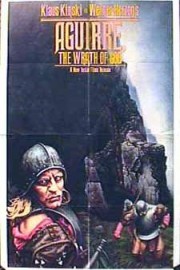Aguirre, the Wrath of God
My first experience with Werner Herzog was around 2002, when I rented “Aguirre, the Wrath of God” through Netflix. Like all great cinema, it shook me and stayed with me. And in the years since, Herzog’s films- be it documentaries like “Grizzly Man” and “Encounters at the End of the World” or features like “Rescue Dawn” and “Bad Lieutenant: Port of Call, New Orleans”- have only increased my appreciation for the German master (one of the finest filmmakers, living or otherwise). Now’s the time to revisit that first unforgettable experience.
A discussion of any Herzog film is impossible without discussing the manner of its’ creation- with no other filmmaker are the two as inseparable. With “Aguirre,” he is telling the story of a doomed expedition. A group of Spaniards, led by local indian tribes, is heading up the Amazon looking for the lost city of El Dorado in the 16th Century. The film is reportedly based on the diary of a priest who was on the expedition.
To film it, Herzog took his cast and crew deep into the Amazon, away from all possible civilization, and built rafts to travel down the raging river. The film wouldn’t be as memorable if he hadn’t. To sense that the filmmakers themselves could suffer the same fate as the expedition they’re recreating gives the film an extraordinary energy it wouldn’t have had if the makers had just recreated the setting on a soundstage. This is the greatest thing about any Herzog film- his vision, his ambition, his worldview is an indelible part of the story he’s telling, be it a documentary like “Grizzly Man” (culled from hours of footage by Timothy Treadwell, who spent 13 summers living among the bears before being eaten by one) or a feature film like “Fitzcarraldo” (in which he actually took a 360-ton ship, still built, from one river system to another, like his subject in the film).
Herzog can be the bleakest of filmmakers depending on the subject, but also one of the most inspiring. This comes from the passion of his craft. His determination to show us something we’ve never seen before, and the manner in which he does so.
Two collaborators are vital to “Aguirre’s” success. The first is the band Popol Vuh, whose music gives the film an otherworldly feel, especially in the opening scene, as we watch a row of Indian helpers and Spanish soldiers- complete with cannons, armor, and hand-held carriages for the ladies of the court- move down a winding path in the jungle, which looks to engulf them. Their music, so haunting, so impossible to separate from the images, has been some of my favorite to listen to recently. It’s unlike anything else heard in film before or since…unless you count their music for “Fitzcarraldo,” or Herzog’s remake of the silent classic “Nosferatu.”
The second is, of course, Klaus Kinski, a legendary figure in world cinema, though more for his very real madness and anger than his over 170 films in his career. Of course, of those, five were for Herzog; according to Roger Ebert in his review of Herzog’s documentary on the actor “My Best Fiend,” no other director worked with him twice, so impossible was he to work with. But then, no other actor could have made us believe the demons of greed, of power, and obsession in Aguirre (or Fitzcarraldo, or Herzog’s Count Orlok) as he stalks around the raft, imposing his will on the soldiers, the noblemen, and the servants whose fates are sealed early on. As he speaks, you feel every syllable is one that comes from madness, from that dark place in the human soul the rest of us hope to never reach. How Herzog survived one film with this man- let alone five (some of which even had actor and director plotting for the other’s death)- is a testament to his own strength, his own conviction.
Sounds and images are what linger in the memory from “Aguirre.” Story is secondary to seeing a world we’ve never experienced before, as is often the case with Herzog (and one wouldn’t have it any other way). The haunted words of the monk. The obsession in Aguirre’s voice. The faces of men and women- hungry, without hope, living in fear of dying where no one can find them. The sight of a native- whose canoe has been sighted by the raft- pointing down river, indicating El Dorado is further, when we know by now it’s out of reach. The canoe in the tree, so high above the river it must be an illusion. “On this river, God never finished his creation.” “I am the Wrath of God.” And the final image of Aguirre, the lone survivor on the raft, surrounded by dead bodies and live monkeys, still planning his New Spain as the raft stands still, the jungle and river having beaten them.










